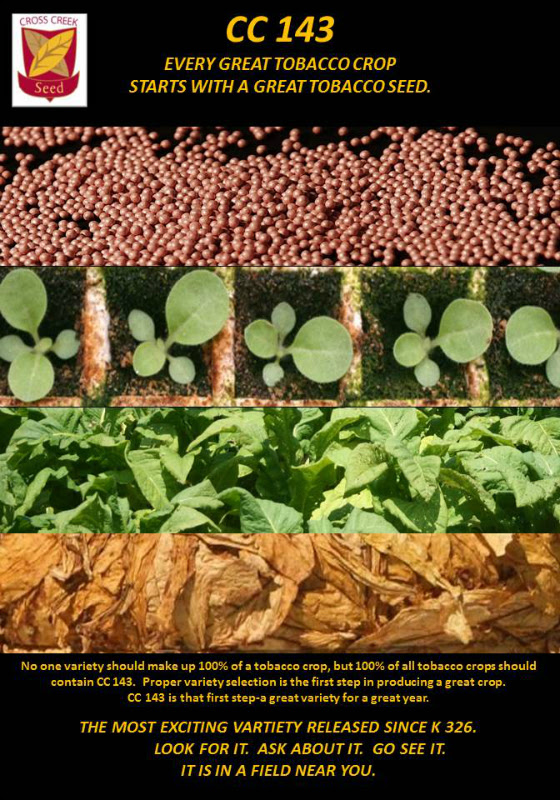|
One seed company gets out of flue-cured. Another gets in. Champion Seed, a 60-year-old company that specializes in vegetable seed, has acquired exclusive rights to market F.W. Rickard's flue-cured varieties after January 1. No change is expected in sales procedures for 2018: If you want Rickard flue-cured seed, simply go to the retailer that has sold them to you before, says Zeb James, Champion sales representative in Arapahoe, N.C. He is not taking orders himself, but if you have questions about the new arrangement, you may call him at 252-637-8903.
Stripping slowed: In parts of the Burley Belt, late November and early December were very dry. That interfered with stripping plans. Now, in some areas, farmers have a lot of tobacco still hanging in barns. East Tennessee is one such place. "We hope we have better conditions for stripping in January than we had in December," says Don Fowlkes, manager of agronomy for Burley Stabilization Corporation in Greeneville, Tn. "Tobacco hasn't come in and out of order much at all. Quality is a mixed bag."
Despite some late planting--and some very late harvesting--the 2017 flue-cured crop turned out fairly well for most growers in the N.C. Piedmont, says Tim Hambrick, N.C. Area Extension tobacco agent stationed in Winston-Salem. "They have a little more money in their pockets than last year," he says. There is a need for some invest-ment on many farms, but not much is likely to be made, due to uncertainty. This season will be remembered for its length: Harvest went well into November here, says Hambrick, in part because rains delayed some planting until late June.
Parts of the fire-cured crop in the Black Patch of Kentucky and Tennessee were harvested later than is desirable too, says Andy Bailey, Extension dark tobacco specialist. This should be avoided whenever possible. "We usually don't do as well with fire-cured that is cut after November 1. The tobacco normally has had some frost damage by that time, and it is more difficult to maintain temperatures that are needed for fire-curing once the weather gets colder in November." He says that is the case even with the newer, tighter barns.
Crop value up in the Commonwealth: The value of the Kentucky tobacco crop rose to around $350 million in 2017, up significantly from the $283 million taken in in 2016, according to University of Kentucky agricultural economists. A better growing season resulted in a higher quantity and quality crop for both burley and dark farmers.
Fewer flue-cured barns for sale? Because the dropout of growers is likely to be less due to the good season we just experienced, not as many used barns--especially not quality barns--will come on the market, says Bob Pope, owner of Long Equipment Manufacturing Company of Tarboro, N.C. On a related note: His company's name has changed from Long Tobacco Barns to Long Equipment Manufacturing, to reflect the broader product line that it now offers.
Meeting demand: Jim Schneeberger has been named Senior Vice President of Leaf Operations and Sales for the U.S. Tobacco Cooperative, part of an effort to better meet international and domestic demand for U.S. flue-cured tobacco while driving volume and growth, according to a USTC announcement. He had previously been USTC vice president for business development.
Briefly noted: Flue-cured grower Jerome Vick of Wilson County, N.C., and machinery manufacturers Randy and Don Watkins, of Granville Equipment Co. in Oxford, N.C., were named "Tobacco Greats" at the recent 2017 N.C. Tobacco Day in recognition of the significant contributions they have made to the tobacco industry.
GAP GROWER TRAINING EVENTS
Check with your local Extension Service office for further details.
All meetings listed here are free and presented in English.
- Jan. 8, 9 a.m. Wilson, N.C.
- Jan. 9, 9 a.m. Yadkinville, N.C.
- Jan. 10, 9 a.m., Rocky Mount, N.C.
- Jan. 11, 9 a.m., Smithfield, N.C.
- Jan. 12, 9 a.m. Oxford, N.C.
- Jan. 22, 9 a.m. Yanceyville, N.C.
- Jan. 22, 6 p.m. Dixon, Ky.
- Jan. 23, 9 a.m. Winston-Salem, N.C.
- Jan. 23, 9 a.m. Blackstone, Va.
- Jan. 23, 9:30 a.m. Dover, Tn.
- Jan. 24, 9 a.m. Williamston, N.C.
- Jan. 24, 4 p.m. South Hill, Va.
- Jan. 25, 9 a.m. Greenville, N.C.
- Jan. 25, 2 p.m., Clinton, N.C.
- Jan. 25, 4 p.m. Chatham, Va.
- Jan. 26, 9 a.m. Kinston, N.C.
- Jan. 29, 9 a.m. Goldsboro, N.C.
- Jan. 30, 9 a.m. Sanford, N.C.
- Jan. 31, 10 a.m. Scottsburg, Va.
- Feb. 2, 1:30 p.m. Raleigh, N.C. (at Southern Farm Show).
- Feb. 5, 9 a.m. Lillington, N.C.
- Feb. 5, 4:30 p.m. Franklin, Ky.
- Feb. 6, 8:30 a.m. Springfield, Tn.
- Feb. 8, 6 p.m. New Tazewell, Tn.
- Feb. 13, 6 p.m. Athens, Tn.
- Feb. 19, 12 p.m. Carthage, Tn.
- Feb. 19, 6 p.m. Hartsville, Tn.
- Feb. 20, 4:30 p.m. Clarksville, Tn.
- Feb. 21, 8:30 a.m. Lawrenceburg, Tn.
- Feb. 26, 4 p.m. Central City, Ky.
- Feb. 26, 6 p.m. Lafayette, Tn.
- Mar 7, 6 p.m. Greeneville, Tn.
- Mar 20, 6:30 p.m. Gray, Tn.
DATES TO REMEMBER
- January 11, 4 p.m. Burley Tobacco Growers Cooperative Association Annual Membership Meeting. Lexington, Ky. Convention Center, 4 p.m. (in conjunction with Tobacco Expo).
- January 12, 12 noon. Council for Burley Tobacco Annual Meeting. Lexington (Ky.) Convention Center (in conjunction with Tobacco Expo).
- January 17-18, 10 a.m. S.C. AgriBiz and Farm Expo Florence (S.C.) Civic Center at the junction of I-95 and I-20.
- January 31-February 2, 9 a.m. Southern Farm Show. N.C. State Fairgrounds, Raleigh, N.C.
- February 2, 10 a.m. Annual Meeting, Tobacco Growers Association of N.C., Holshouser Building, N.C. State Fairgrounds (in conjunction with Southern Farm Show). Meeting ends with lunch.
Editor's Note: We hope you have enjoyed the December II issue of Tobacco Farmer Newsletter. If you haven't signed on to receive the newsletter regularly, please email me at chrisbickers@gmail.com.--Chris Bickers







 442 million pounds in 2016. The 2017 average price per pound in Zimbabwe is expected to have been about $1.34 per pound, which is about the same as in 2016. "A stronger Brazi-lian Real and a larger (US) 2017 crop should lead to higher exports for the 2017 crop," he says.
442 million pounds in 2016. The 2017 average price per pound in Zimbabwe is expected to have been about $1.34 per pound, which is about the same as in 2016. "A stronger Brazi-lian Real and a larger (US) 2017 crop should lead to higher exports for the 2017 crop," he says. still being cut the first week of November. That is risky, says Andy Bailey, Extension dark tobacco specialist. "We usually don't do well with fire-cured that is cut after November 1. There is less chance of good curing weather after that." The rainfall was favorable for most of the dark-producing area in the fall, although there were some heavy rains associated with Hurri-cane Irma, especially around Springfield, Tn., causing some damage.
still being cut the first week of November. That is risky, says Andy Bailey, Extension dark tobacco specialist. "We usually don't do well with fire-cured that is cut after November 1. There is less chance of good curing weather after that." The rainfall was favorable for most of the dark-producing area in the fall, although there were some heavy rains associated with Hurri-cane Irma, especially around Springfield, Tn., causing some damage. tobacco specialist. "Most of our growers were finished by October 20, but there was an area north of Oxford, N.C., on up to the Virginia state line where the crop was behind. There was a mad dash to finish and some had to harvest
tobacco specialist. "Most of our growers were finished by October 20, but there was an area north of Oxford, N.C., on up to the Virginia state line where the crop was behind. There was a mad dash to finish and some had to harvest 









 never run out of the field because of rain." But then it did start raining in mid October, and that helped curing. "With moisture in the air, farmers were better able to get the desirable color." Aiken barned the last of his burley on October 6, a little behind schedule since frost strikes in east Tennessee some years by that time. "But the first significant frost in this area didn't come until the last week of October," he says.
never run out of the field because of rain." But then it did start raining in mid October, and that helped curing. "With moisture in the air, farmers were better able to get the desirable color." Aiken barned the last of his burley on October 6, a little behind schedule since frost strikes in east Tennessee some years by that time. "But the first significant frost in this area didn't come until the last week of October," he says. card, not those of family members or landlords. You have to attend the entire GAP training session--late arrivals will be recorded at the discretion of GAPC Staff. GAP Connections will not add training after the event without verifying attendance with Extension personnel. You can find more information about the Annual GAP Training using the GAP Connections Grower App on the iPhone or Android, by visiting
card, not those of family members or landlords. You have to attend the entire GAP training session--late arrivals will be recorded at the discretion of GAPC Staff. GAP Connections will not add training after the event without verifying attendance with Extension personnel. You can find more information about the Annual GAP Training using the GAP Connections Grower App on the iPhone or Android, by visiting 






